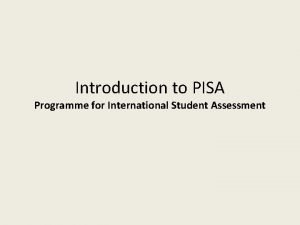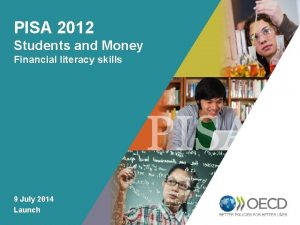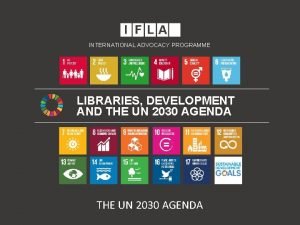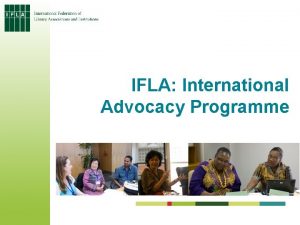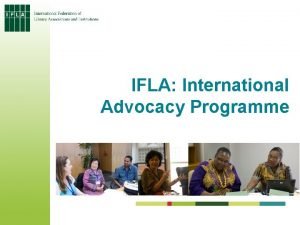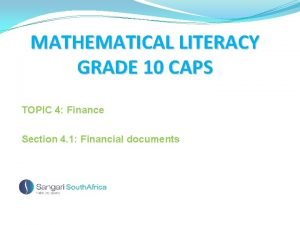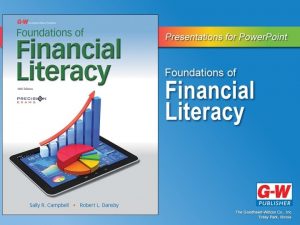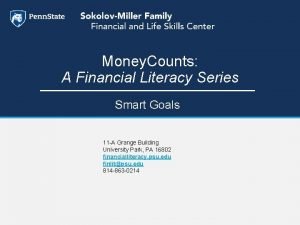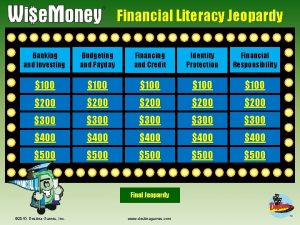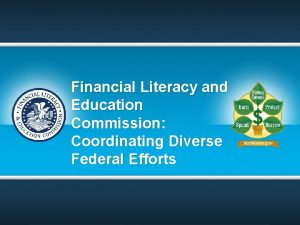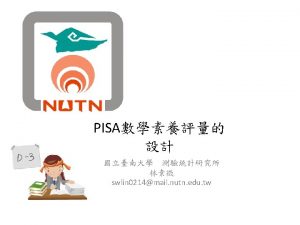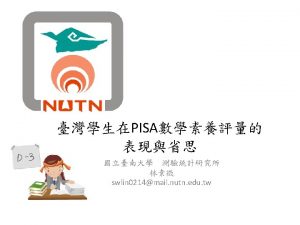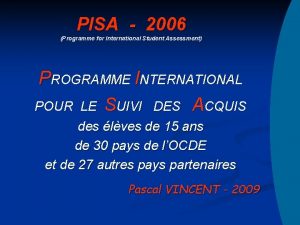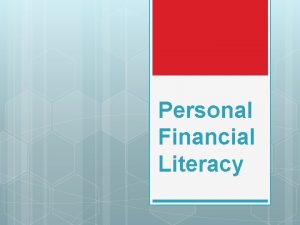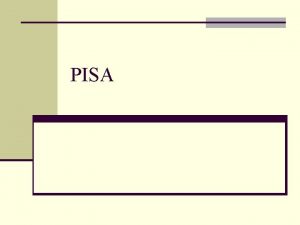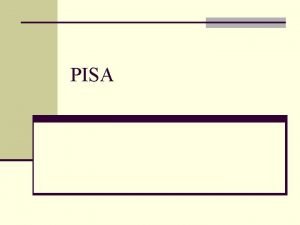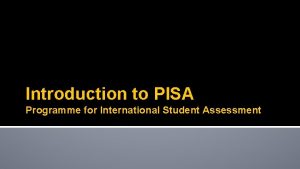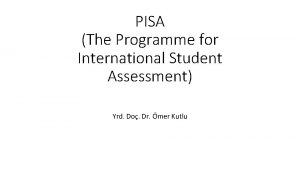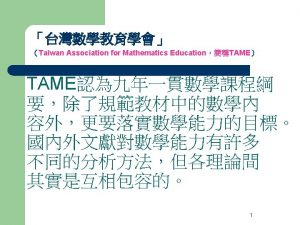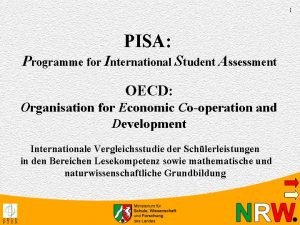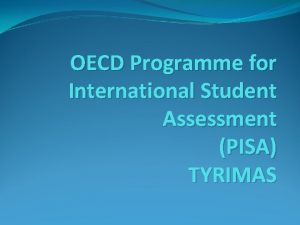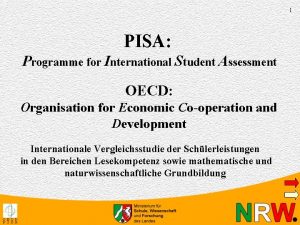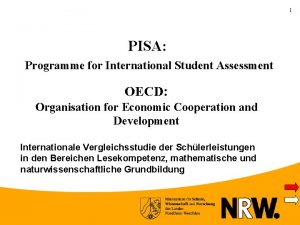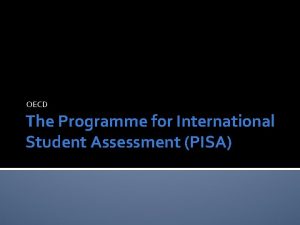PISA Financial Literacy PROGRAMME FOR INTERNATIONAL STUDENT ASSESSMENT






















- Slides: 22

PISA Financial Literacy PROGRAMME FOR INTERNATIONAL STUDENT ASSESSMENT

Objective: The PISA financial literacy test is designed to measure whether students have the knowledge and understanding of financial concepts and risks, as well as the skills, motivation and confidence to apply such knowledge and understanding in order to make effective decisions across a range of financial contexts, to improve the financial well-being of individuals and society, and to enable participation in economic life. The questions are accompanied by information on the concepts and skills tested and what 15 -year-olds students can do at the each of the 5 levels of difficulty.

Framework Dimensions The financial literacy framework is organized into Content, Processes and Contexts (OECD, 2013[1]). Ø Content, Ø Processes Ø Contexts

Content: The content of financial literacy comprises the areas of knowledge and understanding that must be drawn upon in order to perform a particular task. The four content areas for PISA financial literacy are: money and transactions, planning and managing finances, risk and reward, and financial landscape.

Processes: The process categories relate to cognitive processes. They are used to describe students’ ability to recognise and apply concepts relevant to the domain, and to understand, analyse, reason about, evaluate and suggest solutions. In PISA financial literacy, four process categories have been defined: identify financial information, analyse information in a financial context, evaluate financial issues and apply financial knowledge and understanding.

Contexts: Decisions about financial issues often depend on the contexts or situations in which they are presented. By situating tasks in a variety of contexts the assessment offers the possibility of connecting with the broadest possible range of individual interests across a variety of situations in which individuals need to function in the 21 st century. The contexts identified for the PISA financial literacy assessment are, then, education and work, home and family, individual and societal.

Proficiency Levels in Financial Literacy

1. Students can identify common financial products and terms and interpret information relating to basic financial concepts. They can recognise the difference between needs and wants and can make simple decisions on everyday spending. They can recognise the purpose of everyday financial documents such as an invoice and apply single and basic numerical operations (addition, subtraction or multiplication) in financial contexts that they are likely to have experienced personally. 2. Students begin to apply their knowledge of common financial products and commonly used financial terms and concepts. They can use given information to make financial decisions in contexts that are immediately relevant to them. They can recognise the value of a simple budget and can interpret prominent features of everyday financial documents. They can apply single basic numerical operations, including division, to answer financial questions. They show an understanding of the relationships between different financial elements, such as the amount of use and the costs incurred. 3. Students can apply their understanding of commonly used financial concepts, terms and products to situations that are relevant to them. They begin to consider the consequences of financial decisions and they can make simple financial plans in familiar contexts. They can make straightforward interpretations of a range of financial documents and can apply a range of basic numerical operations, including calculating percentages. They can choose the numerical operations needed to solve routine problems in relatively common financial literacy contexts, such as budget calculations.

FINANCIAL QUESTION CATEGORIES ØFINANCIAL CONTENT ØFINANCIAL CONTEXTS ØFINANCIAL LITERACY PROCESSES

FINANCIAL CONTENT: This content area includes the awareness of the different forms and purposes of money and handling simple monetary transactions such as everyday payments, spending, value for money, bank cards, cheques, bank accounts and currencies.

MONEY AND TRANSACTIONS This content area includes the awareness of the different forms and purposes of money and handling simple monetary transactions such as everyday payments, spending, value for money, bank cards, cheques, bank accounts and currencies. PLANNING AND MANAGING FINANCES Income and wealth need planning and managing over both the short term and long term. This content area includes knowledge and ability to monitor income and expenses as well as knowledge and ability to make use of income and other available resources in the short and long terms to enhance financial well-being: RISK AND REWARD Risk and reward is a key area of financial literacy, incorporating the ability to identify ways of managing, balancing and covering risks and an understanding of the potential for financial gains or losses across a range of financial contexts. There are two types of risk of particular importance in this domain. The first relates to financial losses that an individual cannot bear, such as those caused by catastrophic or repeated costs. The second is the risk inherent in financial products, such as credit agreements with variable interest rates, or investment products. FINANCIAL LANDSCAPE This content area relates to the character and features of the financial world. It covers knowing the rights and responsibilities of consumers in the financial marketplace and within the general financial environment, and the main implications of financial contracts. Information resources and legal regulation are also topics relevant to this content area. In its broadest sense, financial landscape also incorporates an understanding of the consequences of changes in economic conditions and public policies, such as changes in interest rates, inflation, taxation or welfare benefits.

FINANCIAL CONTEXTS

EDUCATION AND WORK Education and work questions include understanding payslips, planning to save for higher education, investigating the benefits and risks of taking out a student loan, and participating in workplace savings schemes. HOME AND FAMILY Home and family questions include financial issues relating to the costs involved in running a household such as buying household items or family groceries, keeping records of family spending and making plans for family events. Decisions about budgeting and prioritising spending are also included in this context. INDIVIDUAL Individual questions include contractual issues around events such as opening a bank account, purchasing consumer goods, paying for recreational activities and dealing with relevant financial services that are often associated with larger consumption items, such as credit and insurance. SOCIETAL Societal questions cover matters such as consumer rights and responsibilities, taxes and local government charges, business interests, and consumer purchasing power. Financial choices such as donating to non-profit organisations and charities are also included in this context.

FINANCIAL LITERACY PROCESSES

IDENTIFY FINANCIAL INFORMATION: This process is engaged when the individual searches and accesses sources of financial information, and identifies or recognises its relevance. The information is in the form of printed texts such as contracts, advertisements, charts, tables, forms and instructions. A typical task might ask students to identify the features of a purchase invoice, or recognise the balance on a bank statement. ANALYSE INFORMATION IN A FINANCIAL CONTEXT : Analysing information in a financial context includes interpreting, comparing and contrasting, synthesising, and extrapolating from information that is provided. It involves recognising something that is not explicit: identifying the underlying assumptions or implications of an issue in a financial context e. g. a task may involve comparing the terms offered by different mobile phone contracts, or working aout whether an advertisement for a loan in likely to include unstated conditions. EVALUATE FINANCIAL ISSUES: Evaluating financial issues involves recognising or constructing financial justifications and explanations, drawing on financial knowledge and understanding applied in specified contexts. It involves explaining, assessing and generalising. It also involves critical thinking such as drawing on knowledge, logic and plausible reasoning to make sense of and form a view about a finance-related problem. APPLY FINANCIAL KNOWLEDGE AND UNDERSTANDING : Applying financial knowledge and understanding focuses on taking effective action in a financial setting by using knowledge of financial products and contexts, and understanding of financial concepts. This process is reflected in tasks that involve performing calculations and solving problems, often taking into account multiple conditions. Examples of these kinds of tasks are calculating the interest on a loan over two years or working out whether purchasing power will decline or increase over time when prices are changing at a given rate.

PISA FINANCIAL LITERACY QUESTIONS

MITTAL PVT LTD. COMPANY Invoice Number: 2034 27 April 2019 Date issued: Saurabh Jain Product code Description Quantity Unit cost ( ₹ ) T 011 T-shirt 04 1500 Total ( ₹ ) (excluding tax) 6000 J 023 jeans 03 1700 5100 S 002 scarf 02 300 600 Total Excluding Tax: 11, 700 Tax 10%: 1170

§ SAURABH CHAUDHRY RECEIVES THIS INVOICE IN THE MAIL § ON THE BASIS OF ABOVE INVOICE ANSWER THE QUESTION OF LEVEL-1 AND LEVEL-2. QUESTION LEVEL 1 : How much amount Mr. Saurabh Chaudhry is required to pay on 30 th April: a. ₹ 12, 350 b. ₹ 13, 000 c. ₹ 13, 500 QUESTION LEVEL 2: INVOICE How much has MITTAL PVT LTD. COMPANY charged for delivering the clothes? a. ₹ 13000 b. ₹ 500 c. ₹ 130 d. ₹ 13, 500

QUESTION LEVEL 3 : This graph shows the profit earned by Ramta ltd. over last five years. Profit (₹) 900 000 850 000 800 000 780 000 758 000 700 000 600 000 500 000 480 000 400 000 300 000 200 000 100 0 31 st March 2015 31 st March 2016 31 st March 2017 31 st March 2018 31 st March 2019

QUESTION: QUESTION LEVEL 3: 1. 31 st March 2016 is the most profitable year. a. True b. False 2. The profitability increased over the five years by: a. 60% b. 45% c. 70%

1. A man took loan from a bank at the rate of 12% p. a. simple interest. After 3 years he had to pay Rs. 5400 interest only for the period. The principal amount borrowed by him was: QUESTION LEVEL 4: a. ₹ 2, 000 b. ₹ 10, 000 c. ₹ 15, 000 d. ₹ 20, 000 2. A bank offers 5% compound interest calculated on halfyearly basis. A customer deposits Rs. 1600 each on 1 st. January and 1 st July of a year. At the end of the year, the amount he would have gained by way of interest is: a. ₹ 120 b. ₹ 121 c. ₹ 122 d. ₹ 123

Ravinder banks with ICICI Bank. He receives this e-mail message. Dear ICICI Bank member, QUESTION LEVEL 5 There has been an error on the ICICI Bank server and your Internet login details have been lost. As a result, you have no access to Internet banking. Most importantly your account is no longer secure. Please click on the link below and follow the instructions to restore access. You will be asked to provide your Internet banking details. https: //Zed. Bank. com 1. Which of these statements would be good advice for David? 1. A. Reply to the e-mail message and provide his Internet banking details. (i) Yes (ii) No 1. B. Contact his bank to inquire about the e-mail message. (i) Yes (ii) No 1. C. If the link is the same as his bank’s website address, click on the link and follow the instructions. (i) Yes (ii) No
 Programme for international student assessment 2021
Programme for international student assessment 2021 Pisa financial literacy
Pisa financial literacy Similarities of media literacy and information literacy
Similarities of media literacy and information literacy Difference between media literacy and technology literacy
Difference between media literacy and technology literacy People in media people as media
People in media people as media Cyber literacy for the digital age
Cyber literacy for the digital age Cern openlab summer student programme
Cern openlab summer student programme International cospas-sarsat programme
International cospas-sarsat programme Twitterifla
Twitterifla International advocacy programme
International advocacy programme Pull out you've hit an artery
Pull out you've hit an artery International advocacy programme
International advocacy programme Who programme for international drug monitoring
Who programme for international drug monitoring Bhartiya model of financial literacy
Bhartiya model of financial literacy Water tariffs calculations grade 11
Water tariffs calculations grade 11 What are the asterisks indicating on the till slip
What are the asterisks indicating on the till slip Financial literacy grade 4
Financial literacy grade 4 Chapter 1 financial literacy basics
Chapter 1 financial literacy basics Smart goals financial literacy
Smart goals financial literacy Financial literacy jeopardy
Financial literacy jeopardy Financial literacy and education commission
Financial literacy and education commission Pshe financial education
Pshe financial education Investinwhatsnext
Investinwhatsnext
